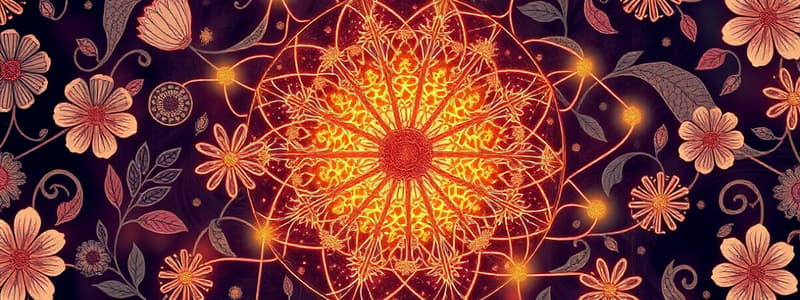Podcast
Questions and Answers
What is the primary function of mitochondria in cells?
What is the primary function of mitochondria in cells?
- To produce ATP, the usable form of energy (correct)
- To store genetic information
- To facilitate cell division
- To synthesize proteins from ribosomes
Which structure of the mitochondria increases its surface area for ATP production?
Which structure of the mitochondria increases its surface area for ATP production?
- Intermembrane space
- Matrix
- Cristae (correct)
- Outer membrane
What characteristic of the outer mitochondrial membrane contributes to its function?
What characteristic of the outer mitochondrial membrane contributes to its function?
- It contains numerous cristae
- It is impermeable to all ions
- It is porous and allows material transport (correct)
- It holds the enzymes needed for ATP production
Which statement accurately describes the inner mitochondrial membrane?
Which statement accurately describes the inner mitochondrial membrane?
What is the significance of mitochondria having their own DNA and ribosomes?
What is the significance of mitochondria having their own DNA and ribosomes?
How does a larger surface area in mitochondria contribute to ATP production?
How does a larger surface area in mitochondria contribute to ATP production?
What role do the enzymes found in the mitochondrial matrix play?
What role do the enzymes found in the mitochondrial matrix play?
What primary role does oxidative phosphorylation serve in eukaryotic cells?
What primary role does oxidative phosphorylation serve in eukaryotic cells?
Which statement accurately describes the composition of the outer mitochondrial membrane?
Which statement accurately describes the composition of the outer mitochondrial membrane?
What is the function of porins in the outer mitochondrial membrane?
What is the function of porins in the outer mitochondrial membrane?
What is the maximum molecular weight that molecules can have to pass through the outer membrane porins?
What is the maximum molecular weight that molecules can have to pass through the outer membrane porins?
How do eukaryotic cells primarily use the ATP produced through oxidative phosphorylation?
How do eukaryotic cells primarily use the ATP produced through oxidative phosphorylation?
Which structure does the outer membrane of mitochondria resemble in its morphological properties?
Which structure does the outer membrane of mitochondria resemble in its morphological properties?
What is the role of the inner membrane in relation to the ATP production process?
What is the role of the inner membrane in relation to the ATP production process?
Which function is NOT associated with the ATP produced in eukaryotic cells?
Which function is NOT associated with the ATP produced in eukaryotic cells?
What feature of the inner membrane significantly increases its surface area?
What feature of the inner membrane significantly increases its surface area?
Which of the following statements regarding the lipid bilayer of the inner membrane is true?
Which of the following statements regarding the lipid bilayer of the inner membrane is true?
What role do transport proteins in the inner membrane serve?
What role do transport proteins in the inner membrane serve?
What is the primary function of the cristae in mitochondria?
What is the primary function of the cristae in mitochondria?
Which components are intercalated within the inner membrane?
Which components are intercalated within the inner membrane?
Which of the following describes the intermembrane space?
Which of the following describes the intermembrane space?
Which of the following best describes the structure of the inner membrane?
Which of the following best describes the structure of the inner membrane?
What does the term 'intercristal space' refer to?
What does the term 'intercristal space' refer to?
Which type of cells typically possess tubular cristae?
Which type of cells typically possess tubular cristae?
What role do the large matrix granules play in the mitochondrial matrix?
What role do the large matrix granules play in the mitochondrial matrix?
Which of the following is NOT a symptom associated with mitochondrial diseases?
Which of the following is NOT a symptom associated with mitochondrial diseases?
What type of genetic material is found within the mitochondrial matrix?
What type of genetic material is found within the mitochondrial matrix?
Which of the following functions is primarily associated with the enzymes in the mitochondrial matrix?
Which of the following functions is primarily associated with the enzymes in the mitochondrial matrix?
Mitochondrial diseases are most closely linked to mutations in which type of DNA?
Mitochondrial diseases are most closely linked to mutations in which type of DNA?
What is the primary function of the cristae in the mitochondrion?
What is the primary function of the cristae in the mitochondrion?
Which of the following statements about mitochondrial ribosomes is true?
Which of the following statements about mitochondrial ribosomes is true?
Which of the following conditions can occur due to mitochondrial malfunction?
Which of the following conditions can occur due to mitochondrial malfunction?
What distinguishes the outer membrane of the mitochondrion from the inner membrane?
What distinguishes the outer membrane of the mitochondrion from the inner membrane?
Which mitochondrial component contributes to the matrix's function in protein and DNA synthesis?
Which mitochondrial component contributes to the matrix's function in protein and DNA synthesis?
What primarily distinguishes sap vacuoles from other types of vacuoles?
What primarily distinguishes sap vacuoles from other types of vacuoles?
Which statement about the tonoplast is accurate?
Which statement about the tonoplast is accurate?
In which type of cell would you most likely find a large central vacuole?
In which type of cell would you most likely find a large central vacuole?
What is the primary function of contractile vacuoles?
What is the primary function of contractile vacuoles?
Which substance is NOT typically found in vacuoles?
Which substance is NOT typically found in vacuoles?
What role does anthocyanin play in sap vacuoles?
What role does anthocyanin play in sap vacuoles?
How are vacuoles formed within the cell?
How are vacuoles formed within the cell?
What is the primary content of food vacuoles?
What is the primary content of food vacuoles?
Which of the following is NOT a characteristic of vacuoles?
Which of the following is NOT a characteristic of vacuoles?
Which type of vacuole is known for its role in excreting excess water?
Which type of vacuole is known for its role in excreting excess water?
Flashcards are hidden until you start studying
Study Notes
Mitochondria Overview
- Mitochondria are double-membrane organelles known as the "powerhouse of the cell."
- They produce ATP (adenosine triphosphate), the usable form of energy for cells.
- Enzymes convert energy from carbohydrates and fatty acids into ATP through oxidative phosphorylation.
Structure of Mitochondria
- Composed of an outer and inner membrane.
- The outer membrane is smooth and porous, allowing small molecules to pass.
- The inner membrane is highly folded into cristae, increasing surface area for ATP production.
- Contains a matrix rich in enzymes necessary for ATP synthesis and has its own DNA and ribosomes, enabling protein synthesis.
Function of Mitochondria
- ATP produced is vital for cellular functions such as movement, reproduction, and synthesis of compounds.
- Plays a crucial role in the oxidation of organic molecules to generate energy.
Outer Membrane Characteristics
- Composed of 50% lipids and 50% proteins.
- Contains transmembrane proteins called porins that form channels for small molecules.
- Allows the passage of molecules with molecular weights up to 10,000 Da.
Inner Membrane Characteristics
- Contains long folds (cristae) to enhance surface area.
- Lipid composition varies and includes unusual phospholipids.
- Highly impermeable to ions and selectively permeable to required small molecules.
- Houses components of the electron transport chain and ATP synthase activity.
Membrane-Limited Spaces
- Creates intermembrane space between the inner and outer membranes.
- The matrix space is enclosed by the inner membrane and contains the mitochondrial matrix.
Mitochondrial Matrix
- Composed of water, solutes, and matrix granules for calcium ion concentration regulation.
- Contains circular DNA and ribosomes.
- Enzymes in the matrix are involved in critical processes including the citric acid cycle and lipid oxidation.
Mitochondrial Diseases
- Include over 40 conditions linked to mitochondrial dysfunction, due to mutations in nuclear or mitochondrial DNA.
- Symptoms vary based on affected tissues, including muscle weakness, digestive problems, and developmental delays.
Vacuoles Overview
- Non-cytoplasmic areas in cells, separated by a membrane known as tonoplast.
- Store water, minerals, and other substances; vital for structure and osmotic pressure.
Types of Vacuoles
- Sap Vacuoles: Abundant in plant cells for storing sap, maintaining turgidity, and osmotic pressure.
- Contractile Vacuoles: Expandable and collapsible; help segregate substances and maintain osmotic balance.
- Food Vacuoles: Store nutrients and participate in digestion via phagocytosis.
- Air Vacuoles: Found in prokaryotes; store gases for buoyancy and structural strength.
Functions of Chloroplasts
- Key roles in photosynthesis and synthesis of nucleic acids, proteins, fatty acids, and vitamins.
Peroxisomes
- Single-membrane spherical organelles involved in hydrogen peroxide metabolism.
- Contain oxidases that produce hydrogen peroxide and catalases that break it down.
- Enzymes in peroxisomes assist in various metabolic reactions, including lipid degradation.
Studying That Suits You
Use AI to generate personalized quizzes and flashcards to suit your learning preferences.




